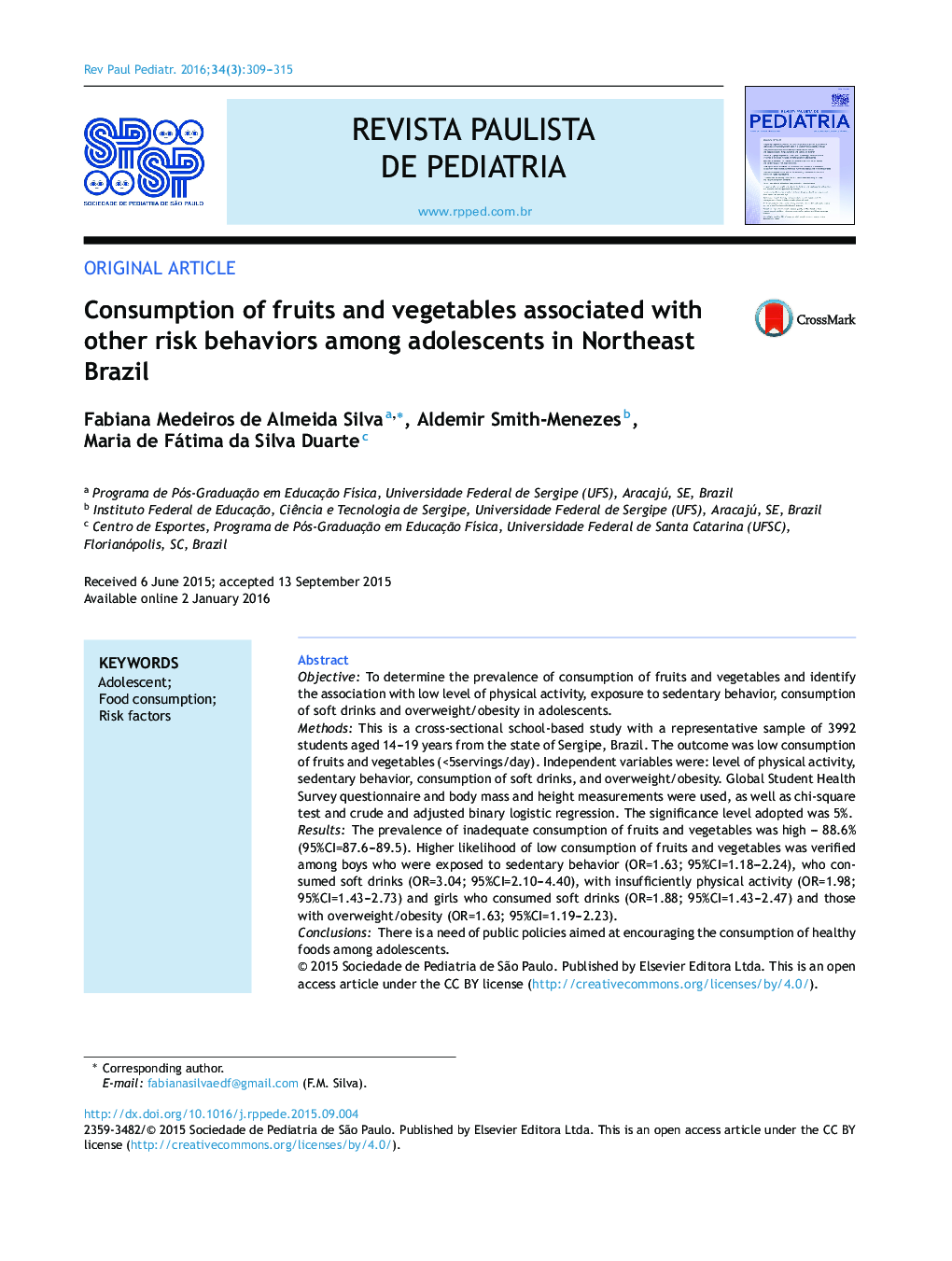| Article ID | Journal | Published Year | Pages | File Type |
|---|---|---|---|---|
| 4176109 | Revista Paulista de Pediatria (English Edition) | 2016 | 7 Pages |
ObjectiveTo determine the prevalence of consumption of fruits and vegetables and identify the association with low level of physical activity, exposure to sedentary behavior, consumption of soft drinks and overweight/obesity in adolescents.MethodsThis is a cross-sectional school-based study with a representative sample of 3992 students aged 14–19 years from the state of Sergipe, Brazil. The outcome was low consumption of fruits and vegetables (<5servings/day). Independent variables were: level of physical activity, sedentary behavior, consumption of soft drinks, and overweight/obesity. Global Student Health Survey questionnaire and body mass and height measurements were used, as well as chi-square test and crude and adjusted binary logistic regression. The significance level adopted was 5%.ResultsThe prevalence of inadequate consumption of fruits and vegetables was high – 88.6% (95%CI=87.6–89.5). Higher likelihood of low consumption of fruits and vegetables was verified among boys who were exposed to sedentary behavior (OR=1.63; 95%CI=1.18–2.24), who consumed soft drinks (OR=3.04; 95%CI=2.10–4.40), with insufficiently physical activity (OR=1.98; 95%CI=1.43–2.73) and girls who consumed soft drinks (OR=1.88; 95%CI=1.43–2.47) and those with overweight/obesity (OR=1.63; 95%CI=1.19–2.23).ConclusionsThere is a need of public policies aimed at encouraging the consumption of healthy foods among adolescents.
ResumoObjetivoDeterminar a prevalência do consumo de frutas e vegetais e identificar a associação com o baixo nível de atividade física, exposição a comportamentos sedentários, consumo de refrigerantes e sobrepeso/obesidade em adolescentes.MétodosEste é um estudo transversal de base escolar com uma amostra representativa de 3992 alunos com idades entre 14 e 19 anos do estado de Sergipe, Brasil. O desfecho foi o baixo consumo de frutas e vegetais (<5 porções/dia). As variáveis independentes foram: nível de atividade física, comportamento sedentário, consumo de refrigerantes, e sobrepeso/obesidade. Foram usados o questionário Global Student Health Survey e o peso corporal e altura, bem como o teste do qui-quadrado e regressão logística binária (análise ajustada e bruta). O nível de significância adotado foi de 5%.ResultadosA prevalência de consumo inadequado de frutas e hortaliças foi alta – 88,6% (IC95%=87,6-89,5). Verificou-se maior probabilidade de baixo consumo de frutas e legumes em meninos que estavam expostos a comportamento sedentário (OR=1,63; IC95%=1,18-2,24), que consumiam refrigerantes (OR=3,04; IC95%=2,10-4,40), com atividade física insuficiente (OR=1,98; IC95%=1,43-2,73) e meninas que consumiam refrigerantes (OR=1,88, IC95%=1,43-2,47) e aquelas com sobrepeso/obesidade (OR=1,63, IC95%=1,19-2,23).ConclusõesHá a necessidade de políticas públicas destinadas a incentivar o consumo de alimentos saudáveis entre os adolescentes.
